
|
Sale 100
September 3-6 2017 Pre Long Beach Sale
| Lot |
Photo |
Description |
Realized |
Lot 2046 |
 |
50-piece hoard of Persian Period, Silver Yehud Coins, before 333 BCE. Consists of AR gerah and AR half-gerah pieces of Samaria and Judah. Although low grade, most are identifiable. An interesting ancient Judaean silver hoard. Estimate Value $500 - UP
The Living Torah Museum, Brooklyn, NY.
View details and enlarged photo
| Realized
$1,293 |
Lot 2047 |
 |
Judaea, Hasmonean Kingdom. Alexander Jannaeus (Yehonatan). Æ Prutah (2.23 g), 103-76 BCE. Jerusalem. 'Yehonatan the King' (Paleo-Hebrew), lily, within circular beaded border. Reverse: [B]AΣIΛEΩ AΛE[ΞANΔPOY], inverted anchor within circle. Hendin 1148; TJC grp. N. Nearly Extremely Fine. Estimate Value $200 - 250
Ex Superior (3 June 1998), 6530.
This emission seems to look back to the Seleukid coinage struck by John Hyrcanus I for his ostensible overlord, the Seleukid king Antiochos VII Sidetes in 132-130 BCE. Both feature a lily on the obverse as a symbol of Jerusalem and an anchor as a badge of royal (Seleukid) authority. Here, however, Jannaeus seems to use it as a means of indicating his legitimacy as the successor to the now feeble and virtually extinct line of Seleukid kings. It is no accident that the Paleo-Hebrew legend appears alongside the Jewish emblem of the lily while the Greek legend is associated with the anchor.
View details and enlarged photos
| Unsold |
Lot 2048 |
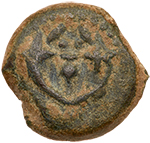 |
Judaea, Hasmonean Kingdom. Alexander Jannaeus. Æ Prutah (2.18 g), 103-76 BCE. Jerusalem. 'Yehonatan the High Priest and the Council of the Jews' (Paleo-Hebrew) in four lines within wreath. Reverse: Double cornucopiae adorned with ribbons, pomegranate between horns. Hendin 1149; TJC grp. T. Sandy patina. Very Fine. Estimate Value $100 - 130
View details and enlarged photos
| Unsold |
Lot 2049 |
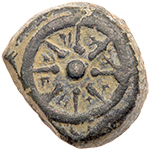 |
Judaea, Hasmonean Kingdom. Alexander Jannaeus (Yehonatan). Æ Prutah (3.06 g), 103-76 BCE. Jerusalem. 'Yehonatan the King' (Paleo-Hebrew) between the rays of star with eight rays, all within diadem. Reverse: BAΣIΛEΩΣ AΛEΞANΔPOY, inverted anchor. Hendin 1150; TJC grp. K. Dark green patina. Extremely Fine. Estimate Value $100 - 130
Easily the most well known of Alexander Jannaeus' prutah coinages, this issue boldly advertises his status as king while paying attention to Jewish prohibitions against graven images of living things which had evolved since the time of the Yehud coinages in the fourth century BCE. While contemporary Seleukid and Ptolemaic kings regularly had their diademed portraits shown on their coins, Jannaeus was forced to content himself with depicting a star - apparently as a cipher for his image - surrounded by a diadem. It is unclear whether the star was meant to give a messianic flavor to Jannaeus' somewhat brutal style of kingship, but the anchor reverse casts him as a successor to dying Seleukid power in the Southern Levant.
View details and enlarged photos
| Realized
$59 |
Lot 2050 |
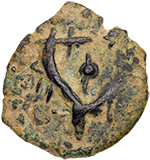 |
Judaea, Hasmonean Kingdom. John Hyrcanus II. Æ Prutah (2.58 g), 67 and 63-40 BCE. Jerusalem. 'Yonatan the High Priest and the Council of the Jews' (Paleo-Hebrew, highly stylized) within wreath. Reverse: Double cornucopiae adorned with ribbons, pomegranate between horns. Hendin 1159; TJC grp. S. Sandy patina. Extremely Fine. Estimate Value $100 - 130
View details and enlarged photos
| Unsold |
Lot 2051 |
 |
Judaea, Hasmonean Kingdom. Mattathias Antigonos (Mattatayah). Æ 8 Prutot (14.29 g), 40-37 BCE. Jerusalem. 'Mattatayah the High Priest and Council of the Jews' (Paleo-Hebrew), double cornucopiae. Reverse: BACIΛEΩC [ANTIΓONOY], ivy wreath tied with ribbons. Hendin 1162; TJC 36. Glossy chocolate brown patina. Very Fine. Estimate Value $300 - 350
In 40 BCE, at the head of a Parthian army, Mattathias II Antigonus drove Herod the Great and his puppet, the Hasmonaean ethnarch, John Hyrcanus II, out of Jerusalem and was proclaimed king and High Priest by the Parthians and his Jewish supporters. Unfortunately, the wily Herod was not so easily defeated and returned in 39 BCE armed with recognition as the Roman client-king of Judaea. The hapless Mattathias II was ultimately defeated and crucified for his troubles, leaving Judaea to begin a new period in its troubled history under the often hated Herodian dynasty.
View details and enlarged photos
| Unsold |
Lot 2052 |
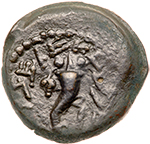 |
Judaea, Hasmonean Kingdom. Mattathias Antigonos (Mattatayah). Æ 4 Prutot (8.14 g), 40-37 BCE. Jerusalem. 'Mattatayah the High Priest' (Paleo-Hebrew), cornucopiae tied with ribbons, decorated with vine-leaf and grapes. Reverse: [B]AC[IΛ]/EOC AN/TIΓON in two lines within wreath tied at left. Hendin 1163; TJC 37a. Dark green patina. Rare this nice. Choice Very Fine. Estimate Value $250 - 300
View details and enlarged photos
| Realized
$141 |
Lot 2053 |
 |
Judaea, Hasmonean Kingdom. Mattathias Antigonos (Mattatayah). Æ 4 Prutot (7.12 g), 40-37 BCE. Jerusalem. 'Mattatayah the High Priest' (Paleo-Hebrew), cornucopiae tied with ribbons, decorated with vine-leaf and grapes. Reverse: [BACIΛ/EOC AN/TIΓON] (mostly illegible) in three lines within wreath tied at left. Hendin 1163; TJC 37a. Brown patina. Very Fine. Estimate Value $250 - 300
View details and enlarged photos
| Realized
$141 |
Lot 2054 |
 |
Judaea, Hasmonean Kingdom. Mattathias Antigonos (Mattatayah). Æ 4 Prutot (7.06 g), 40-37 BCE. Jerusalem. 'Mattatayah the High Priest' (Paleo-Hebrew), cornucopiae tied with ribbons, decorated with vine-leaf and grapes. Reverse: BACIΛ/EOC AN/TIΓON in three lines within wreath tied at left. Hendin 1163; TJC 37a. Brown patina. Very Fine. Estimate Value $250 - 300
View details and enlarged photos
| Realized
$176 |
Lot 2055 |
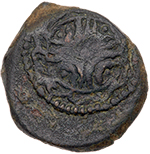 |
Judaea, Herodian Kingdom. Herod I. Æ 4 Prutot (4.56 g), 40 BCE-4 CE. Uncertain mint in Samaria, RY 3 (40/39 or 38/7 BCE). Shield with decorated rim. Reverse: [B]AΣIΛEΩ[Σ H]PΩ[ΔOY], crested helmet; in left field, date (L Γ); in right field, monogram. Hendin 1170; TJC 45. Dark green patina. Very Fine. Estimate Value $250 - 300
View details and enlarged photos
| Realized
$141 |
Lot 2056 |
 |
Judaea, Herodian Kingdom. Herod I. Æ 2 Prutot (2.95 g), 40 BCE-4 CE. Uncertain mint in Samaria, RY 3 (40/39 or 38/7 BCE). Poppy on stalk. Reverse: BAΣIΛEΩΣ HPΩΔOY, winged caduceus; in left field, date (L Γ); in right field, monogram. Hendin 1171; TJC 46. Desert green patina. Very Fine. Estimate Value $250 - 300
View details and enlarged photos
| Realized
$141 |
Lot 2057 |
 |
Judaea, Herodian Kingdom. Herod I. Æ 2 Prutot (3.43 g), 40 BCE.-4 CE. Jerusalem. BACIΛEOC HPOΔ, cross within closed diadem. Reverse: Tripod flanked by palm branches. Hendin 1178; TJC 48. Sandy green patina. Very Fine. Estimate Value $250 - 300
View details and enlarged photos
| Unsold |
Lot 2058 |
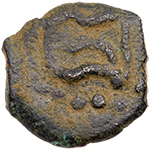 |
Judaea, Herodian Kingdom. Herod I. Æ 1/2 Prutah (1.25 g), 40 BCE-4 CE. Jerusalem. BAC[IΛEOC HPΩΔOY], small closed diadem. Reverse: Tripod table. Hendin 1183; TJC 54. Sandy green patina. Very Fine. Estimate Value $150 - 200
View details and enlarged photos
| Realized
$89 |
Lot 2059 |
 |
Judaea, Herodian Kingdom. Herod I. Æ 1/2 Prutah (0.89 g), 40 BCE-4 CE. Jerusalem. [BAC]IΛEOC H[PΩΔOY], tripod table with something upon it. Reverse: Two crossed palm branches in circle. Hendin 1185; TJC 55. Scarce. Earthen brown patina. Very Fine. Estimate Value $200 - 250
View details and enlarged photos
| Realized
$165 |
Lot 2060 |
 |
Judaea, Herodian Kingdom. Herod I. Æ 1/2 Prutah (0.89 g), 40 BCE-4 CE. Jerusalem. [B]ACIΛ[EOC HPΩΔOY], tripod table with something upon it. Reverse: Two crossed palm branches in circle. Hendin 1185; TJC 55. Scarce. Dark green patina. Fine. Estimate Value $150 - 200
View details and enlarged photos
| Unsold |
Lot 2061 |
 |
Judaea, Herodian Kingdom. Herod I. Æ Lepton (0.87 g), 40 BCE.-4 CE. Jerusalem. BACIΛ HPω[Δ], cornucopiae. Reverse: Eagle standing right. Hendin 1190; TJC 66. Very Scarce. Very Fine. Estimate Value $150 - 200
View details and enlarged photos
| Realized
$88 |
Lot 2062 |
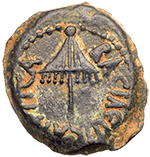 |
Judaea, Herodian Kingdom. Agrippa I. Æ Prutah (2.45 g), 37-44 CE. Jerusalem, RY 6 (41/2 CE). BACIΛE[OC] AΓPIΠΠA, umbrella-like canopy. Reverse: Three grain ears; across field, date (L ?). Hendin 1244; TJC 120. Extremely Fine. Estimate Value $150 - 200
View details and enlarged photos
| Realized
$165 |
Lot 2063 |
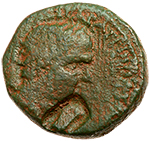 |
Judaea, Herodian Kingdom. Agrippa I. Æ 20 (6.42 g), 37-44 CE. Caesarea Maritima, RY 7 (42/3 CE). [BACILEVC M]EΓAC AΓPIΠΠ[AC ΦIΛOKAICAP], diademed head of Agrippa I right; c/m: head(?) left within oval incuse. Reverse: [KAICAPIA H ΠPOC TΩ CEBACTΩ ΛIMHNI], Tyche standing facing. head left, holding rudder and palm; in right field, date (L H). Hendin 1250; TJC 126; RPC 4986; for c/m: cf. Howgego 156. Very Rare. Green patina with light deposits. Very Fine. Estimate Value $2,000 - 2,500
From the Dr. Patrick Tan Collection.
View details and enlarged photos
| Realized
$1,763 |
Lot 2064 |
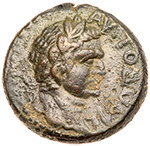 |
Judaea, Herodian Kingdom. Agrippa II. Æ (2.70 g), 56-95 CE. Caesarea Paneas. AYTO ΔOMI, laureate head of Domitian right. Reverse: BA AΓP/ET EΛ in two lines within wreath. Hendin 1300; TJC 182; RPC 2299. Brown-green patina. Choice Very Fine. Estimate Value $300 - 350
View details and enlarged photos
| Realized
$317 |
Lot 2065 |
|
20-piece Bronze collection of Judaean. Includes coins of the following: Hasmonean Dynasty, Herodian Dynasty, Roman Governors and Bar Kokhba Revolt. Mostly different and partially attributed. Includes some scarce and better quality specimens. Inspection is recommend prior to bidding. Lot of 20 coins. Estimate Value $1,000 - UP
View details
| Realized
$588 |
Lot 2066 |
|
7-piece collection of the Roman Governors of Judaea. Consists of the following AE prutah: H-1329, H-1334, H-1335, H-1339, H-1440, H-1348, H-1351. All are Very Fine and better. Each carefully selected for quality by the collector. Lot of 7 coins. Estimate Value $500 - 600
View details
| Realized
$294 |
Lot 2067 |
 |
Judaea, The Jewish War. Silver Shekel (14.02 g), 66-70 CE. Jerusalem, year 1 (66/7 CE). 'Shekel of Israel' (Paleo-Hebrew), ritual chalice with wide, smooth rim, pellet on either side, and flat base with pearled ends; above, '[year] 1'. Reverse: 'Jerusalem [the] holy' (Paleo-Hebrew), staff with three pomegranate buds, round base. Hendin 1354; TJC 187. Early crude style and and outstanding example of the type. Excellent old tone. Extremely Fine. Estimate Value $10,000 - 13,000
A Connoisseur's Collection of Ancient Jewish Coins.
The silver shekel of the first year (May 66-March 67 CE) of the Jewish War against Rome is perhaps one of the most iconic coins in the ancient Jewish coin series. The chalice on the obverse is widely believed to represent the omer cup used in the Jerusalem Temple while the reverse may represent a staff with three pomegranates. The pomegranate was a traditional symbol of Jewish priestly authority. It has been argued recently, however, that earlier scholars may have been right to understand this type not as an allegorical emblem of the priesthood but as a representation of the budding almond staff of Aaron that was kept in the Ark of the Covenant.
View details and enlarged photos
| Realized
$21,738 |
Lot 2068 |
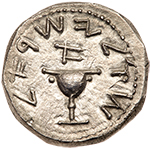 |
Judaea, The Jewish War. Silver Shekel (13.84 g), 66-70 CE. Jerusalem, year 1 (66/7 CE). 'Shekel of Israel' (Paleo-Hebrew), ritual chalice with wide, smooth rim, pellet on either side, and flat base with pearled ends; above, '[year] 1'. Reverse: 'Jerusalem [the] holy' (Paleo-Hebrew), staff with three pomegranate buds, round base. Hendin 1354; TJC 187. Fine style. Boldly struck, lightly toned. Superb Extremely Fine. Estimate Value $8,000 - 9,000
A Connoisseur's Collection of Ancient Jewish Coins.
View details and enlarged photos
| Realized
$17,625 |
Lot 2069 |
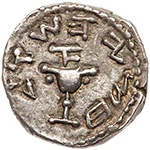 |
Judaea, The Jewish War. Silver 1/2 Shekel (6.70 g), 66-70 CE. Jerusalem, year 1 (66/7 CE). 'Half of a shekel' (Paleo-Hebrew), ritual chalice with wide, smooth rim, pellet on either side, and flat base with pearled ends; above, '[year] 1'. Reverse: 'Jerusalem [the] holy' (Paleo-Hebrew), staff with three pomegranate buds, round base. Hendin 1355; TJC 188. Perfectly centered and boldly struck. Extremely Fine. Estimate Value $10,000 - 13,000
A Connoisseur's Collection of Ancient Jewish Coins.
The dramatic first year (May 66-March 67 CE) of the Jewish War against Rome gave some hope that the Jewish rebels might actually win their independence. Late in 66 CE they defeated the XII Legion commanded by the Roman procurator Cestius Gallus. Some of the silver coinage struck in this year may perhaps have been produced from the booty carried off by the victorious Jews in this confrontation. Unfortunately, this Roman defeat led to Vespasian's transfer to the theater of conflict and the eventual quashing of the revolt in the Galilee.
View details and enlarged photos
| Realized
$21,738 |
Lot 2070 |
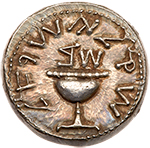 |
Judaea, The Jewish War. Silver Shekel (14.30 g), 66-70 CE. Jerusalem, year 2 (67/8 CE). 'Shekel of Israel' (Paleo-Hebrew), ritual chalice with pearled rim, the base raised by projections on both ends; above, 'year 2'. Reverse: 'Jerusalem the holy' (Paleo-Hebrew), staff with three pomegranate buds, round base. Hendin 1358; TJC 193. Boldly struck with delicate iridescent tone. Superb Extremely Fine. Estimate Value $7,000 - 8,000
A Connoisseur's Collection of Ancient Jewish Coins; Ex Sternberg XXVI (16 November 1992), 146.
The second year of the Jewish War against Rome (April 67-March 68 CE) saw the Zealot-led rebellion in the Galilee crushed by the forces of Vespasian, soon to become the imperial successor of Nero. During this campaign, the future historian Josephus was famously placed in command of the fortress at Gamla. When it was clear that all was lost, the leadership agreed not to surrender to the Romans, choosing instead to die by killing one other by lot. When all were dead but Josephus and one other man, they both fearing death, surrendered to the Romans. Thanks to this, Josephus lived on for many years, writing his account of the war responsible for coins like this shekel.
View details and enlarged photos
| Realized
$8,813 |
Lot 2071 |
 |
Judaea, The Jewish War. Silver Shekel (13.44 g), 66-70 CE. Jerusalem, year 2 (67/8 CE). 'Shekel of Israel' (Paleo-Hebrew), ritual chalice with pearled rim, the base raised by projections on both ends; above, 'year 2'. Reverse: 'Jerusalem the holy' (Paleo-Hebrew), staff with three pomegranate buds, round base. Hendin 1358; TJC 193. Toned. A very pleasing example. About Extremely Fine. Estimate Value $4,000 - 5,000
Ex The Living Torah Museum, Brooklyn, New York.
View details and enlarged photos
| Realized
$5,288 |
Lot 2072 |
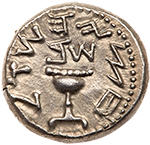 |
Judaea, The Jewish War. Silver 1/2 Shekel (6.87 g), 66-70 CE. Jerusalem, year 2 (67/8 CE). 'Half of a shekel' (Paleo-Hebrew), ritual chalice with pearled rim, the base raised by projections on both ends; above, 'year 2'. Reverse: 'Jerusalem the holy' (Paleo-Hebrew), staff with three pomegranate buds, round base. Hendin 1359; TJC 195. Lightly toned and wonderful metal. Superb Extremely Fine. Estimate Value $7,000 - 8,000
Ex Antiqua XII (2003), 91 A Connoisseur's Collection of Ancient Jewish Coins.
View details and enlarged photos
| Realized
$23,500 |
Lot 2073 |
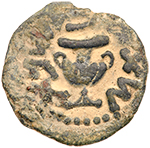 |
Judaea, The Jewish War. Æ Prutah (3.35 g), 66-70 CE. Jerusalem, year 2 (67/8 CE). 'Year two' (Paleo-Hebrew), amphora with broad rim and two handles. Reverse: 'The freedom of Zion' (Paleo-Hebrew), vine leaf on small branch with tendril. Hendin 1360; TJC 196. Earthen patina. Extremely Fine. Estimate Value $150 - 200
Although struck by the Jewish rebels against Rome, the the prutot of the Jewish War take much of their typological inspiration from the earlier coinages struck for Judaea by the Roman praetorial government. The amphora and vine leaf types come very close to those used for an issue of Valerius Gratus in 17/8 CE.
View details and enlarged photos
| Realized
$106 |
Lot 2074 |
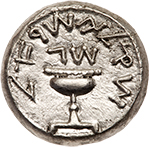 |
Judaea, The Jewish War. Silver Shekel (14.16 g), 66-70 CE. Jerusalem, year 3 (68/9 CE). 'Shekel of Israel' (Paleo-Hebrew), ritual chalice with pearled rim, the base raised by projections on both ends; above, 'year 3'. Reverse: 'Jerusalem the holy' (Paleo-Hebrew), staff with three pomegranate buds, round base. Hendin 1361; TJC 202. Perfectly struck and perfectly centered. Mint State. Estimate Value $10,000 - 13,000
A Connoisseur's Collection of Ancient Jewish Coins.
The third year (April 68-May 69 CE) of the Jewish War saw some slight respite from the Roman advance as the death of Nero plunged the Roman Empire into a civil war into which Vespasian was drawn. However, violence in Jerusalem reached new heights as the Zealot leaders of the crushed northern revolt waged their own civil war against Ananus ben Ananus, the leader of the more moderate priestly authorities. This factional conflict resulted in an ignominious siege of Jerusalem by the Zealots and the slaughter of Ananus and his adherents. Jerusalem the holy, as it is described on the shekels, had been defiled by the blood of its own people before ever the Romans entered the city.
View details and enlarged photos
| Realized
$19,388 |
Lot 2075 |
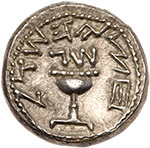 |
Judaea, The Jewish War. Silver 1/2 Shekel (6.95 g), 66-70 CE. Jerusalem, year 3 (68/9 CE). 'Half of a shekel' (Paleo-Hebrew), ritual chalice with pearled rim, the base raised by projections on both ends; above, 'year 3'. Reverse: 'Jerusalem the holy' (Paleo-Hebrew), staff with three pomegranate buds, round base. Hendin 1362; TJC 203. Magnificent! Perfectly centered and perfectly struck. Delicately toned. Superb Extremely Fine. Estimate Value $7,000 - 8,000
A Connoisseur's Collection of Ancient Jewish Coins.
View details and enlarged photos
| Realized
$25,850 |
Lot 2076 |
 |
Judaea, The Jewish War. Æ Quarter (10.58 g), 66-70 CE. Jerusalem, year 4 (69/70 CE). 'Year four, quarter' (Paleo-Hebrew), two lulav branches. Reverse: 'To the redemption of Zion' (Paleo-Hebrew), etrog. Hendin 1368; TJC 213. Very Rare. Lovely greenish-brown patina. Seldom seen this choice. Well centered with full legends. An outstanding example. Extremely Fine. Estimate Value $7,000 - 8,000
A Connoisseur's Collection of Ancient Jewish Coins.
The lulav branches and etrog types depicted on the token bronze quarter shekels of the fourth year (April 69-March 70 CE) of the Jewish War refer to Sukkot, the Feast of Tabernacles, which was both a harvest celebration and a commemoration of the deliverance of the Israelites from slavery in Egypt. This typology may appear at this time because the rebels had reached the point of no return and had no hope of surviving the coming Roman onslaught without divine aid.
View details and enlarged photos
| Realized
$4,348 |
Lot 2077 |
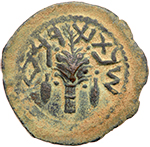 |
Judaea, The Jewish War. Æ Eighth (7.01 g), 66-70 CE. Jerusalem, year 4 (69/70 CE). 'Year four' (Paleo-Hebrew), lulav branch flanked by an etrog on either sider. Reverse: 'To the redemption of Zion' (Paleo-Hebrew), chalice with pearled rim. Hendin 1369; TJC 214. Perfectly centered with full legends. Green patina with earthen highlights. Extremely Fine. Estimate Value $500 - 600
Ex Heritage Sale 3032, lot 23445 A Connoisseur's Collection of Ancient Jewish Coins.
View details and enlarged photos
| Realized
$676 |
Lot 2078 |
 |
Judaea, The Jewish War. Æ Eighth (5.75 g), 66-70 CE. Jerusalem, year 4 (69/70 CE). 'Year four' (Paleo-Hebrew), lulav branch flanked by an etrog on either sider. Reverse: 'To the redemption of Zion' (Paleo-Hebrew), chalice with pearled rim. Hendin 1369; TJC 214. Reddish brown patina. Very Fine. Estimate Value $250 - 300
View details and enlarged photos
| Realized
$223 |
Lot 2079 |
 |
Judaea, The Jewish War. Æ Eighth (5.11 g), 66-70 CE. Jerusalem, year 4 (69/70 CE). 'Year four' (Paleo-Hebrew), lulav branch flanked by an etrog on either sider. Reverse: 'To the redemption of Zion' (Paleo-Hebrew), chalice with pearled rim. Hendin 1369; TJC 214. Chocolate brown patina. Very Fine. Estimate Value $250 - 300
View details and enlarged photos
| Realized
$153 |
Lot 2080 |
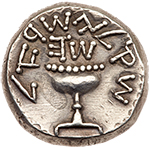 |
Judaea, The Jewish War. Silver Shekel (13.34 g), 66-70 CE. Irregular issue. Year 5 (April-August 70 CE). 'Shekel of Israel' around, 'year 5' above, ritual chalice with pearled rim, the base raised by projections on ends. Reverse: 'Jerusalem the holy', sprig of three pomegranates. Hendin 1370a; TJC 215a. One of the finest from the Baldwin Hoard.
See Hendin p. 363 for a concise and interesting summary of the Baldwin Hoard. Nearly Mint State. Estimate Value $25,000 - UP
Ex Shoshana Collection, pt. II (Heritage, 5 September 2012), 20128 A Connoisseur's Collection of Ancient Jewish Coins.
Year 5 shekels are the rarest of all the shekels minted during the Jewish War. There were only four months that year to strike them before Titus captured Jerusalem and destroyed the Temple in the Fall of 70 CE. Nevertheless, during the last months of the siege when all commerce as well as the striking of bronze coins came to a halt, it was important to continue striking coins in silver in order for the Jews to continue to pay the half-shekel Temple tax, as commanded in Exodus 30.13. Several year 5 shekels were among the coins excavated at Masada, one of the most famous rebel strongholds against the Romans, which notoriously held out against them for three more years after Vespasian and Titus celebrated their Triumph in 71 CE. It is therefore known that at least some Jewish fighters were able to escape Jerusalem just before it fell. After the war, it was forbidden to use coins of the revolt, so the shekels were melted down into ingots, for their silver value.
Josephus (de Bello Judaico 7.320-406) tells us that when at length it became evident that the Romans would prevail, the rebel commander of the zealot group known as the Sicarii, Eleazar ben Ya'ir, convinced his men to kill their wives and children and then to commit suicide, thereby depriving the Romans of the glory of taking them captives and sparing themselves from slavery.
View details and enlarged photos
| Realized
$48,175 |
Lot 2081 |
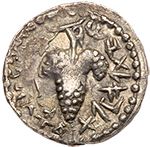 |
Judaea, Bar Kokhba Revolt. Silver Zuz (2.58 g), 132-135 CE. Year 1 (132/3 CE). 'Eleazar the priest' (Paleo-Hebrew), jug with handle; at right, willow branch. Reverse: 'Year one of the redemption of Israel' (Paleo-Hebrew), grape bunch with branch and small leaf. Hendin 1374; cf. Mildenberg 2/5 (O1/R3); TJC 219. Extremely Rare - die combination not recorded by Mildenberg. Traces of undertype visible. Extremely Fine. Estimate Value $20,000 - 25,000
A Connoisseur's Collection of Ancient Jewish Coins; Ex NAC 78 (26 May 2014), 341.
The silver zuzim of the Bar Kokhba War were regularly overstruck on Roman imperial denarii and provincial drachms from Cappadocia and Bostra that had been captured by the rebels from the invading Roman forces. The types seem to be influenced by the bronze prutot of the earlier Jewish Revolt (66-73 CE) which featured an amphora and a vine leaf. The zuzim of the Bar Kokhba War mirror this typology by depicting a grape bunch on the obverse and a one-handled jug on the reverse, and those of the first year of the war (132/3 CE) are especially notable because they name "Eleazar the priest," a mysterious figure who disappears from the coins in the subsequent years of issue except for some mules. It is often suggested that he is none other than Rabbi Eleazar of Modein, an uncle of Simon bar Kokhba who seems to have lent his religious authority to the cause of war against the Romans. Later, after having begun doubting his actions and planning to surrender to the forces of Hadrian, Bar Kokhba reportedly kicked him to death.The branch to the right of the jug has traditionally been identified as a palm branch. In "The Temple Willow-Branch Ritual Depicted on Bar Kokhba Denarii," INJ 16 (2007-2008), pp. 131-5, Y. Adler argues that it is in fact a willow branch, and represents the willow branch ceremony that took place along with the water ceremony (represented by the jug) at the Temple altar during the Feast of Tabernacles.
View details and enlarged photos
| Realized
$28,200 |
Lot 2082 |
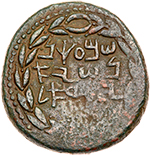 |
Judaea, Bar Kokhba Revolt. Æ Large Bronze (24.56 g), 132-135 CE. Year 1 (132/3 CE). 'Simon, Prince of Israel' (Paleo-Hebrew) within wreath. Reverse: 'Year one of the redemption of Israel' (Paleo-Hebrew), amphora with two handles. Hendin 1376; Mildenberg 9 (O2/R4); TJC 220. Extremely Rare - only three specimens cited by Mildenberg. Pleasing dark green patina. Bold. Very Fine. Estimate Value $5,000 - 6,000
A Connoisseur's Collection of Ancient Jewish Coins.
This variety of the large bronze denomination of the first year (132/3 CE) of the Bar Kokhba War (132-135 CE) is notable for its obverse paleo-Hebrew legend which does not name Jerusalem within the wreath anymore, but rather Simon [bar Kokhba] as nasi (president) of Israel. Although nasi is sometimes translated as "prince" rather than "president," it almost certainly refers to Simon bar Kokhba's role as the leader of the Great Sanhedrin (the Jewish religious assembly that originally held court in the Jerusalem Temple before its destruction). The title of nasi was also held by the Hasmonaean High Priest John Hyrcanus I (134-104 BC), who engineered full autonomy for Judaea and who also struck coins featuring a wreathed legend on the obverse.
View details and enlarged photos
| Realized
$5,875 |
Lot 2083 |
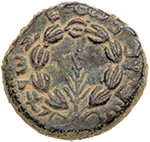 |
Judaea, Bar Kokhba Revolt. Æ Medium Bronze (12.58 g), 132-135 CE. Year 1 (132/3 CE). 'Simon, Prince of Israel' (Paleo-Hebrew), palm branch within wreath. Reverse: 'Year one of the redemption of Israel' (Paleo-Hebrew), wide lyre with four strings. Hendin 1377; Mildenberg 21 (O1/R2); TJC 223. Lovely green patina. Extremely Fine. Estimate Value $600 - 700
Ex Heritage Sale, Afril 2014, lot 23451 A Connoisseur's Collection of Ancient Jewish Coins.
The reverse type of this bronze denomination of the first year (132/3 CE) of the Bar Kokhba War is commonly identified as a nevel, a stringed instrument thought to have been similar to the Greek chelys. Although the kinnor - a related instrument similar to the Greek kithara - was prescribed as an instrument to be played in the Jerusalem Temple, the nevel had an even more important status in some rabbinical Jewish traditions. It was said that the world was actually sung into existence to the accompaniment of a perfect 22-stringed nevel. The reverberating notes of these strings subsequently became the 22 letters of the Hebrew alphabet. Considering the messianic flavor of the Bar Kokhba revolt one wonders whether the nevel type alludes to a new creation for Judaea free from Roman oppression. The palm branch on the obverse may perhaps celebrate the early victories of the Bar Kokhba rebels during "year one of the redemption of Israel."
View details and enlarged photos
| Realized
$1,175 |
Lot 2084 |
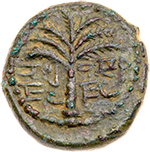 |
Judaea, Bar Kokhba Revolt. Æ Small Bronze (6.92 g), 132-135 CE. Year 1 (132/3 CE). 'Eleazar the priest' (Paleo-Hebrew), seven-branched palm tree with two bunches of dates. Reverse: 'Year one of the redemption of Israel' (Paleo-Hebrew), bunch of grapes with branch and small leaf. Hendin 1380; Mildenberg 147 (O1/R1); TJC 224. Reddish brown patina. Superb Extremely Fine. Estimate Value $1,000 - 1,300
A Connoisseur's Collection of Ancient Jewish Coins.
The small bronze denomination of the first year (132/3 CE) of the Bar Kokhba War is typologically connected to the middle bronze palm tree denominations. The palm tree emblem of Judaea appears again on the obverse, but on the reverse the vine leaf of the middle bronze denomination is replaced by a grape bunch. In contrast to the medium bronze denominations, the small denomination does not name Simon bar Kokhba, but Eleazar the priest.
View details and enlarged photos
| Realized
$793 |
Lot 2085 |
 |
Judaea, Bar Kokhba Revolt. Æ Small Bronze (7.04 g), 132-135 CE. Year 1 (132/3 CE). 'Eleazar the priest' (Paleo-Hebrew), seven-branched palm tree with two bunches of dates. Reverse: 'Year one of the redemption of Israel' (Paleo-Hebrew), bunch of grapes with branch and small leaf. Hendin 1380; Mildenberg 150 (O1/R4); TJC 224. Dark reddish-green patina. Extremely Fine. Estimate Value $350 - 450
View details and enlarged photos
| Realized
$282 |
Lot 2086 |
 |
Judaea, Bar Kokhba Revolt. Silver Zuz (2.57 g), 132-135 CE. Hybrid year 1/2 (132/3-133/4 CE). 'Year one of the redemption of Israel' (Paleo-Hebrew), bunch of grapes with branch and small leaf. Reverse: 'Year two of the freedom of Israel' (Paleo-Hebrew), wide lyre with three strings and four dots on sound box. Hendin 1383; Mildenberg 9 (O1/R7); TJC 236. Very Rare - only six examples cited by Mildenberg. Lightly toned. Choice Very Fine. Estimate Value $5,000 - 6,000
A Connoisseur's Collection of Ancient Jewish Coins.
View details and enlarged photos
| Realized
$7,931 |
Lot 2087 |
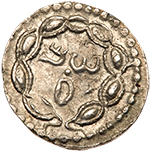 |
Judaea, Bar Kokhba Revolt. Silver Zuz (3.27 g), 132-135 CE. Year 2 (133/4 CE). 'Sma' (Paleo-Hebrew) within wreath of thin branches wrapped around eight almonds, with a medallion at top and tendrils at bottom. Reverse: 'Eleazar the priest' (Paleo-Hebrew), fluted jug with handle on left; in right field, willow branch. Hendin 1384; Mildenberg 8 (O4/R6); TJC 235. A superb example. Well struck on excellent metal and lightly toned. Among the finest quality hybrid we have handled. Underlying luster present. Superb Extremely Fine. Estimate Value $5,000 - 6,000
A Connoisseur's Collection of Ancient Jewish Coins; Ex Heritage Auction 3032, lot 23456.
This interesting zuz mules two obverse dies of different years of the Bar Kokhba War. The wreathed obverse die with the abbreviated name of Simon bar Kokhba belongs to the second year (132/3 CE) while the jug obverse die belongs to the first year and names Eleazar the priest. It has been suggested that Simon's name is abbreviated here (and on other coins) in such a way that it could also be read as the word shema ("hear"), the first word in Deuteronomy 6: 4 ("Hear, O Israel: The Lord is our God, the Lord is One.") which is the centerpiece of morning and evening Jewish prayer known as the Shema Yisrael. Based on this view it has been further proposed that the Shema prayer served as a rallying cry for the Bar Kokhba rebels.
View details and enlarged photos
| Realized
$3,173 |
Lot 2088 |
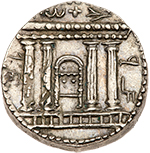 |
Judaea, Bar Kokhba Revolt. Silver Sela (13.47 g), 132-135 CE. Year 2 (133/4 CE). 'Jerusalem' (Paleo-Hebrew), tetrastyle façade of the Temple of Jerusalem; show bread table or Ark of the Covenant in chest form with semicircular lid and short legs, seen from a narrow side; above façade, + dividing legend. Reverse: 'Year two of the freedom of Israel' (Paleo-Hebrew), lulav with etrog at left. Hendin 1386; Mildenberg 11.7 (O2/R9; this coin); TJC 229. Lightly toned. Extremely Fine / Very Fine. Estimate Value $8,000 - 9,000
A Connoisseur's Collection of Ancient Jewish Coins; Ex Alan Levin Collection (Goldberg, 28 May 2007), 2552; Abramowitz Collection (Superior, 8 December 1993), 87; El Fawar Hoard.
View details and enlarged photos
| Realized
$9,400 |
Lot 2089 |
 |
Judaea, Bar Kokhba Revolt. Silver Sela (14.40 g), 132-135 CE. Year 2 (133/4 CE). 'Jerusalem' (Paleo-Hebrew), tetrastyle façade of the Temple of Jerusalem; show bread table or Ark of the Covenant in chest form with semicircular lid and short legs, seen from a narrow side; above façade, +. Reverse: 'Year two of the freedom of Israel' (Paleo-Hebrew), lulav with etrog at left. Hendin 1387a; Mildenberg 15.11 (O4/R8; this coin); TJC 230. Nicely toned. Choice Very Fine. Estimate Value $6,000 - 7,000
A Connoisseur's Collection of Ancient Jewish Coins; Ex Shoshana Collection, pt. II (Heritage, 5 September 2012), 20165; A. Bromberg by private treaty; Beit Umar Hoard.
View details and enlarged photos
| Realized
$8,519 |
Lot 2090 |
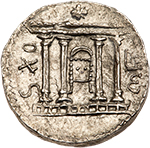 |
Judaea, Bar Kokhba Revolt. Silver Sela (15.05 g), 132-135 CE. Year 2 (133/4 CE). 'Simon' (Paleo-Hebrew), tetrastyle façade of the Temple of Jerusalem; show bread table or Ark of the Covenant in chest form with semicircular lid and short legs, seen from a narrow side; above façade, star. Reverse: 'Year two of the freedom of Israel' (Paleo-Hebrew), lulav with etrog at left. Hendin 1388; Mildenberg 28 (O6/R19); TJC 233. Underlying luster present and lightly toned. Superb Extremely Fine. Estimate Value $7,000 - 8,000
A Connoisseur's Collection of Ancient Jewish Coins.
The sela'im of the second year (133/4 CE) of the Bar Kokhba War depart from the previous issues of the first and second years in the paleo-Hebrew obverse legend. Here, instead of the usual legend naming Jerusalem, now Simon [bar Kokhba] is named. It is unclear whether this change indicates that all hope of reclaiming the site of Jerusalem had been given up by the rebels by this point in the war or whether it merely indicates an increased emphasis on Bar Kokhba's personal leadership as a messianic figure.It should be noted that it is unlikely that Bar Kokhba's soldiers ever occupied Jerusalem. In all of the archaeological excavations that have been conducted there, tens of thousands of coins have been found, but only three of them were coins of Bar Kokhba.
View details and enlarged photos
| Realized
$9,400 |
Lot 2091 |
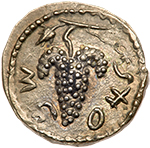 |
Judaea, Bar Kokhba Revolt. Silver Zuz (2.59 g), 132-135 CE. Year 2 (133/4 CE). 'Simon', bunch of grapes with leaf and tendril. Reverse: 'Year two of the freedom of Israel' (Paleo-Hebrew), upright palm branch. Hendin 1394; Mildenberg 42 (O8/R24); TJC 248. A magnificent example! Beautiful light iridescent tones. Among the finest year 2 examples seen. Nearly Mint State. Estimate Value $1,000 - 1,400
A Connoisseur's Collection of Ancient Jewish Coins.
View details and enlarged photos
| Realized
$2,585 |
Lot 2092 |
 |
Judaea, Bar Kokhba Revolt. Silver Zuz (3.08 g), 132-135 CE. Year 2 (133/4 CE). 'Simon', bunch of grapes with leaf and tendril. Reverse: 'Year two of the freedom of Israel' (Paleo-Hebrew), elongated lyre with three strings. Hendin 1396; Mildenberg 47 (O8/R27); TJC 242. Underlying luster present. Superb Extremely Fine. Estimate Value $1,000 - 1,300
A Connoisseur's Collection of Ancient Jewish Coins.
The zuz of the second year (133/4 CE) of the Bar Kokhba War depict the kinnor, a lyre-like instrument played during worship in the Jerusalem Temple before its destruction. Indeed, the Mishna tells us that the minimum number of kinnorim to be played in the Temple was nine, but there was no maximum limit. This musical allusion to the religious services in the Temple is in keeping with the symbolic program of the Bar Kokhba War coinage, which depicts the façade of the Temple as well as other objects associated with religious observances and Jewish festivals.
View details and enlarged photos
| Realized
$3,525 |
Lot 2093 |
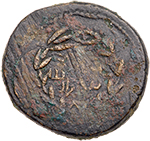 |
Judaea, Bar Kokhba Revolt. Æ Large Bronze (25.52 g), 133-134 CE. Year 2 (133/4 CE). 'Jerusalem' (Paleo-Hebrew) within wreath. Reverse: 'Year two of the redemption of Israel' (Paleo-Hebrew), amphora with two handles. Hendin 1404; Mildenberg 16.5 (O3/R11; this coin); TJC 255. Very Rare - Mildenberg cites just six specimens. Dark reddish-brown patina. Very Fine. Estimate Value $5,000 - 6,000
A Connoisseur's Collection of Ancient Jewish Coins; Ex Shoshana Collection, pt. II (Heritage, 5 September 2012), 24768; Virgil M. Brand Collection, pt. 3 (Sotheby's, 9 June 1983), 155;; Maltiel-Gerstenfeld Collection; Mayer Offenbach Collection.
The large bronze denomination of the second year (133/4 CE) of the Bar Kokhba War is often known by the Arabic nickname "Abu Jara" meaning "father of the jar" because of its very large size and its prominent depiction of an amphora or jar ("jara"). Unlike the majority of the Bar Kokhba coins struck in the second year, this one names Jerusalem rather than Simon bar Kokhba on the obverse, and uses a die employed for first year large bronzes (Hendin 1375).
View details and enlarged photos
| Realized
$8,813 |
Lot 2094 |
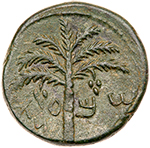 |
Judaea, Bar Kokhba Revolt. Æ Medium Bronze (11.93 g), 132-135 CE. Year 2 (133/4 CE). 'Sma' (abbreviating Simon; Paleo-Hebrew), seven-branched palm tree with two bunches of dates. Reverse: 'Year two of the redemption of Israel' (Paleo-Hebrew), vine leaf on tendril. Hendin 1408; Mildenberg 87 (O7/R51); TJC 260a. Lovely green patina. Extremely Fine. Estimate Value $500 - 600
A Connoisseur's Collection of Ancient Jewish Coins.
The middle bronze denomination of the second year (133/4 CE) of the Bar Kokhba War maintained the same palm tree and vine leaf types of the first year, no doubt because they had become such distinctive symbols of Judaea and the Jews in the first century CE and appealed to the nationalist sentiment of the rebels.
View details and enlarged photos
| Realized
$881 |
Lot 2095 |
 |
Judaea, Bar Kokhba Revolt. Silver Sela (14.68 g), 132-135 CE. Undated, attributed to year 3 (134/5 CE). 'Simon' (Paleo-Hebrew), tetrastyle façade of the Temple of Jerusalem; show bread table or Ark of the Covenant in chest form with semicircular lid and short legs, seen from a narrow side; above façade, wavy line. Reverse: 'For the freedom of Jerusalem' (Paleo-Hebrew), lulav with etrog at left. Hendin 1413; Mildenberg 93 (O17/R64'); TJC 269. Lustroous. Nearly Mint State. Estimate Value $6,000 - 7,000
A Connoisseur's Collection of Ancient Jewish Coins; Ex NFA XVII (27 June 1986), 108.
View details and enlarged photos
| Realized
$6,521 |
|
|